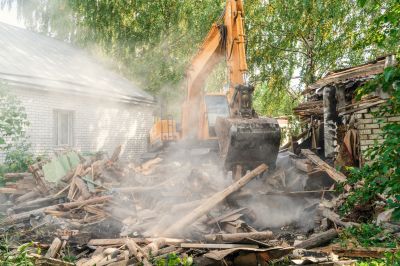Favorite Demolition Service Products for Safe and Effective Projects
Browse through popular tools and machinery designed to streamline demolition operations and ensure safety standards.
 Demolition projects in Murphy, NC, require a diverse array of tools and equipment to ensure safety and efficiency. From small-scale interior demolitions to large structural removals, having the right products can significantly impact the workflow. Essential equipment includes various hand tools like sledgehammers and pry bars, which are fundamental for breaking down materials manually. Power tools such as jackhammers, rotary hammers, and demolition saws provide increased power and speed, making challenging tasks more manageable. Heavy machinery like mini excavators and skid steer loaders equipped with specialized attachments can handle larger debris and facilitate site clearing. Safety gear is equally important, with protective helmets, gloves, eye protection, and respirators helping to safeguard workers during demolition activities. Proper planning and selecting suitable equipment tailored to the scope of the project can lead to smoother operations and safer work environments.
Demolition projects in Murphy, NC, require a diverse array of tools and equipment to ensure safety and efficiency. From small-scale interior demolitions to large structural removals, having the right products can significantly impact the workflow. Essential equipment includes various hand tools like sledgehammers and pry bars, which are fundamental for breaking down materials manually. Power tools such as jackhammers, rotary hammers, and demolition saws provide increased power and speed, making challenging tasks more manageable. Heavy machinery like mini excavators and skid steer loaders equipped with specialized attachments can handle larger debris and facilitate site clearing. Safety gear is equally important, with protective helmets, gloves, eye protection, and respirators helping to safeguard workers during demolition activities. Proper planning and selecting suitable equipment tailored to the scope of the project can lead to smoother operations and safer work environments.
Top Overall Option
Cordless Demolition Hammer
A versatile cordless demolition hammer provides mobility and power for various demolition tasks. Its lightweight design and battery operation make it suitable for both indoor and outdoor projects, offering convenience without sacrificing performance. Ideal for breaking concrete, masonry, and other hard materials, this tool can adapt to different job requirements, making it a valuable addition to any demolition toolkit.
Types of Products For Demolition Service
Sledgehammers
Heavy-duty hand tools used for breaking concrete, brick, and other tough materials, ideal for manual demolition tasks.
Pry Bars
Essential for prying apart materials and removing nails or fasteners during demolition projects.
Rotary Hammers
Power tools designed for drilling and chiseling into concrete and masonry surfaces efficiently.
Jackhammers
Pneumatic or electric tools used for breaking up large areas of concrete or asphalt quickly.
Reciprocating Saws
Handheld saws suitable for cutting through wood, metal, and drywall in demolition scenarios.
Demo Saws
Heavy-duty circular saws designed for cutting through thick materials like concrete and steel.
Mini Excavators
Compact excavators equipped with various attachments for digging, lifting, and debris removal.
Skid Steer Loaders
Versatile machines with attachments such as breakers and buckets for efficient site clearing.
Concrete Crushers
Specialized attachments or standalone equipment for crushing concrete debris into manageable sizes.
Dust Masks and Respirators
Protective gear essential for safeguarding workers from dust and airborne particles.
Safety Helmets
Head protection to prevent injuries from falling debris or accidental impacts.
Work Gloves
Protect hands from cuts, abrasions, and vibrations during demolition activities.
Lifting Straps and Slings
Equipment used for safely lifting and maneuvering heavy debris or materials.
Debris Chutes
Devices that facilitate the safe and efficient removal of debris from elevated work areas.
Vibratory Plate Compactors
Tools used for compacting soil or debris after demolition to prepare for new construction.
Hydraulic Breakers
Powerful attachments for excavators used to break through tough materials like rock or concrete.
Popular Choices
Popular for their portability and ease of use on various demolition projects.
Widely used for their reliability and power in breaking up concrete and asphalt.
Favored for drilling and chiseling tasks in concrete and masonry work.
Commonly chosen for their maneuverability and versatility on small to medium sites.
Preferred for their multifunctionality and efficiency in debris removal.
Popular for manual demolition tasks requiring leverage and prying power.
Essential for ensuring worker protection during demolition activities.
Commonly used for precise cuts in concrete and steel structures.
Increasingly popular for maintaining cleaner work environments.
Often used after demolition to prepare surfaces for construction.
In demand for their power and efficiency when attached to excavators.
Frequently selected for safe handling of heavy debris.
Popular for facilitating quick and safe debris disposal.
Worn regularly for safety compliance and worker comfort.
Helpful for illuminating work areas in low-light conditions.
Increasingly favored for their convenience and mobility.
Key Buying Considerations
- Project scope and size to determine appropriate equipment scale.
- Power source compatibility, such as electric, pneumatic, or battery-powered tools.
- Material types being demolished, including concrete, steel, wood, or drywall.
- Safety features and certifications to ensure compliance and protection.
- Ease of operation and ergonomics for worker comfort.
- Durability and build quality for long-term use in demanding environments.
- Availability of replacement parts and maintenance support.
- Compatibility of attachments and accessories with existing equipment.
- Site conditions, including space constraints and accessibility.
- Budget constraints balanced with quality and performance needs.
- Weight and portability of hand tools for ease of handling.
- Noise levels and vibration to minimize worker fatigue and disturbance.
- Environmental considerations, such as dust control and waste management.
- Training requirements for operators to ensure safe and effective use.
- Availability of rental options for infrequent or short-term projects.
